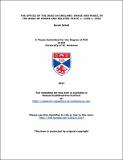Files in this item
The Office of the Dead in England : image and music in the Book of Hours and related texts, c. 1250-c. 1500
Item metadata
| dc.contributor.advisor | Luxford, Julian | |
| dc.contributor.author | Schell, Sarah | |
| dc.coverage.spatial | 330 | en_US |
| dc.date.accessioned | 2011-12-12T15:43:07Z | |
| dc.date.available | 2011-12-12T15:43:07Z | |
| dc.date.issued | 2011 | |
| dc.identifier | uk.bl.ethos.552612 | |
| dc.identifier.uri | https://hdl.handle.net/10023/2107 | |
| dc.description.abstract | This study examines the illustrations that appear at the Office of the Dead in English Books of Hours, and seeks to understand how text and image work together in this thriving culture of commemoration to say something about how the English understood and thought about death in the fourteenth and fifteenth centuries. The Office of the Dead would have been one of the most familiar liturgical rituals in the medieval period, and was recited almost without ceasing at family funerals, gild commemorations, yearly minds, and chantry chapel services. The Placebo and Dirige were texts that many people knew through this constant exposure, and would have been more widely known than other 'death' texts such as the Ars Moriendi. The images that are found in these books reflect wider trends in the piety and devotional practice of the time. The first half of the study discusses the images that appear in these horae, and the relationship between the text and image is explored. The funeral or vigil scene, as the most commonly occurring, is discussed with reference to contemporary funeral practices, and ways of reading a Book of Hours. Other iconographic themes that appear in the Office of the Dead, such as the Roman de Renart, the Pety Job, the Legend of the Three Living and the Three Dead, the story of Lazarus, and the life of Job, are also discussed. The second part of the thesis investigates the musical elaborations of the Office of the Dead as found in English prayer books. The Office of the Dead had a close relationship with music, which is demonstrated through an examination of the popularity of musical funerals and obits, as well as in the occurrence of musical notation for the Office in a book often used by the musically illiterate. The development of the Office of the Dead in conjunction with the development of the Books of Hours is also considered, and places the traditions and ideas that were part of the funeral process in medieval England in a larger historical context. | en_US |
| dc.language.iso | en | en_US |
| dc.publisher | University of St Andrews | |
| dc.subject | Medieval | en_US |
| dc.subject | Art history | en_US |
| dc.subject | Illumination | en_US |
| dc.subject | Books of hours | en_US |
| dc.subject | Psalters | en_US |
| dc.subject | England | en_US |
| dc.subject | Catholicism | en_US |
| dc.subject | Lay piety | en_US |
| dc.subject | Literacy | en_US |
| dc.subject | Music | en_US |
| dc.subject | Death | en_US |
| dc.subject | Commemorative practices | en_US |
| dc.subject | Tombs | en_US |
| dc.subject | Memorials | en_US |
| dc.subject | Death ritual | en_US |
| dc.subject | Burial practices | en_US |
| dc.subject.lcc | ND3363.S3 | |
| dc.subject.lcsh | Illumination of books and manuscripts, Medieval--England | en_US |
| dc.subject.lcsh | Catholic Church. Officium pro defunctis | en_US |
| dc.subject.lcsh | Books of hours--England | en_US |
| dc.subject.lcsh | Death in art | en_US |
| dc.subject.lcsh | Catholic Church--Liturgy--Illustrations | en_US |
| dc.subject.lcsh | Death--England--History--To 1500 | en_US |
| dc.subject.lcsh | Funeral music--England--History--To 1500 | en_US |
| dc.title | The Office of the Dead in England : image and music in the Book of Hours and related texts, c. 1250-c. 1500 | en_US |
| dc.type | Thesis | en_US |
| dc.type.qualificationlevel | Doctoral | en_US |
| dc.type.qualificationname | PhD Doctor of Philosophy | en_US |
| dc.publisher.institution | The University of St Andrews | en_US |
This item appears in the following Collection(s)
Items in the St Andrews Research Repository are protected by copyright, with all rights reserved, unless otherwise indicated.

